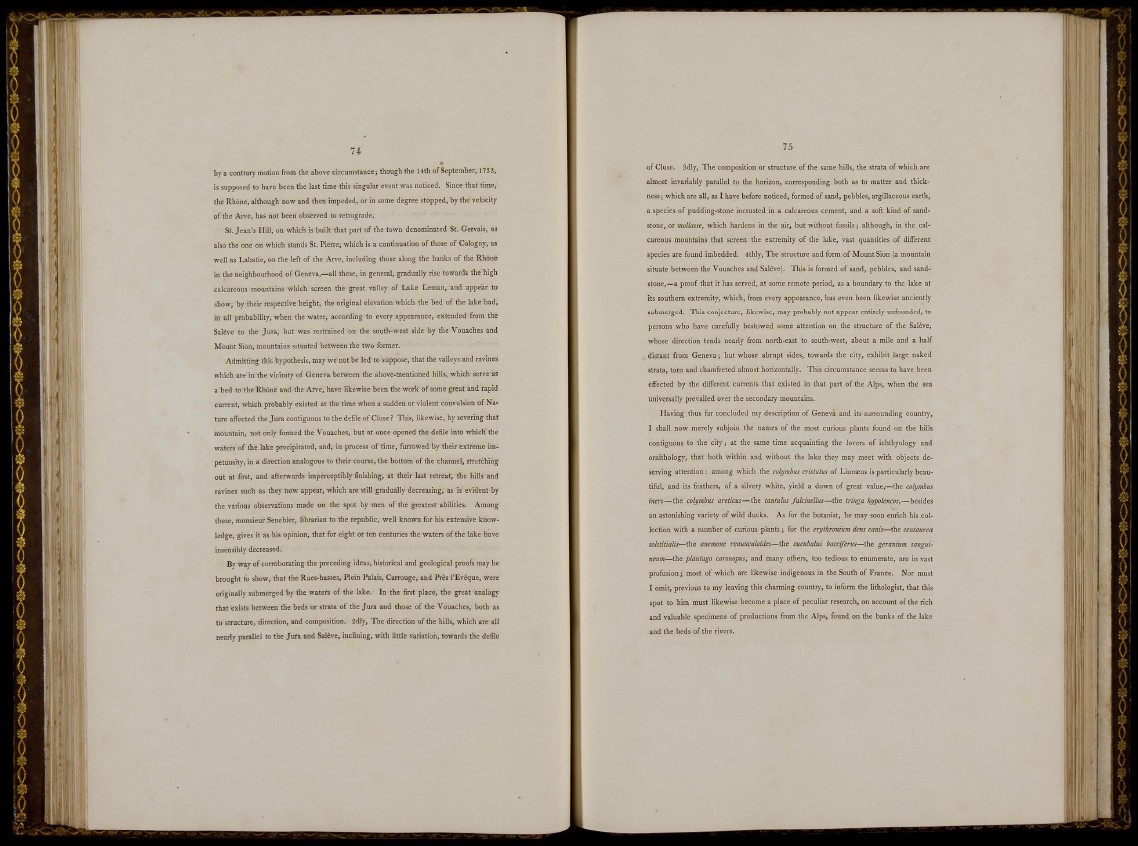
a
..•M.
by a contrary motion from the above circumstance; though the Ut h of September, 1733,
ÎS supposed to have been the last time this singular event was noticed. Since that time,
the Rhône, although now and then impeded, or in some degree stopped, by the velocity
of the Arve, has not been observed to retrograde.
St. Jean's Hill, on which is buiit that part of the town denominated St. Gervais, as
also the one on which stands St. Pierre, which is a continuation of those of Cologny, as
well as Labatie, on the left of the Arve, including those along the banks of the Rhône
in the neighbourhood of Geneva,—all these, in general, gradually rise towards the high
calcareous mountains which screen the great valley of Lake Leman, and appear to
show, by their respective height, the original elevation which the bed of the lake had,
in all probability, when the water, according to every appearance, extended from the
Salêve to the Jura, but was restrained on the south-west side by the Vouaches and
Mount Sion, mountains situated between the two former.
Admitting this hypothesis, may we not be led to suppose, that the valleys and ravines
which are in the vicinity of Geneva between the above-mentioned hills, which serve as
a bed to the Rhône and the Arve, have likewise been the work of some great and rapid
current, which probably existed at the time when a sudden or violent convulsion of Nature
affected the Jur a contiguous to the defile of Cluse ? This, likewise, by severing that
mountain, not only formed the Vouaches, but at once opened the defile into which the
waters of the lake precipitated, and, in process of time, furrowed by their extreme impetuosity,
in a direction analogous to their course, the bottom of the channel, stretching
out at first, and afterwards imperceptibly finishing, at their last retreat, the hills and
ravines such as they now appear, which are still gradually decreasing, as is evideiit by
the various observations made on the spot by men of the greatest abilities. Among
these, monsieur Senebier, librarian to the republic, well known forhis extensive knowledge,
gives it as his opinion, that for eight or ten centuries the waters of the lake have
insensibly decreased.
By way of corroborating the preceding ideas, historical and geological proofs may be
brought to show, that the Rues-basses, Plein Palais, Carrouge, and Près l'Evêque, were
originally submerged by the waters of the lake. In the first place, the great analogy
that exists between the beds or strata of the Jura and those of the Vouaches, both as
to structure, direction, and composition. 2diy, The direction of the hills, which are all
nearly parallel to the Jura and Salêve, inclining, with little variation, towards the defile
of Cluse. 3dly, The composition or structure of the same hills, the strata of which are
almost invariably parallel to the horizon, corresponding both as to matter and thickness;
which are ail, as I have before noticed, formed of sand, pebbles, argillaceous earth,
a species of pudding-stone incrusted in a calcareous cement, and a soft kind of sandstone,
or moUasse, which hardens in the air, but without fossils j although, in the calcareous
mountains that screen the extremity of tlie lake, vast quantities of different
species are found imbedded. 4thly, The structure and form of Mount Sion (a mountain
situate between the Vouaches and Saleve). This is formed of sand, pebbles, and sandstone,—
a proof that it has served, at some remote period, as a boundary to the lake at
its southern extremity, which, from every appearance, has even been likewise anciently
submerged. This conjecture, likewise, may probably not appear entirely unfounded, to
persons who have carefully bestowed some attention on the structure of the Saleve,
whose direction tends nearly from north-east to south-west, about a mile and a half
distant from Geneva j but whose abrupt sides, towards the city, exhibit large naked
strata, torn and chamfreted almost horizontally. This circumstance seems to have been
effected by the different currents that existed in that part of the Alps, when the sea
universally prevailed over the secondary mountains.
Having thus far concluded my description of Geneva and its surrounding country,
I shall now merely subjoin the names of the most curious plants found on the hills
contiguous to the city; at the same time acquainting the lovers of ichthyology and
ornithology, that both within and without the lake they may meet with objects deserving
attention : among which the colyinbus cristalus of Linnaus is particularly beautiful,
and its feathers, of a silvery white, yield a down of great value,—the colymhus
ineis—the colymbus aretiais—the tantulus falcinelliis—the tringa kypolencos,—besides
an astonishing variety of wild ducks. As for the botanist, he may soon enrich his collection
with a number of curious plants j for the eiylhronium dens canis—the centaurca
solstitialis—the anemone renunculoides—the cuaibalus bacci/eriis—the geranium sanguineus—
the planiago coronopus, and many others, too tedious to enumerate, are in vast
profusion 5 most of which are likewise indigenous in the South of France. Nor must
I omit, previous to my leaving this charming country, to inform the lithologist, that this
spot to him must likewise become a place of peculiar research, on account of the rich
and valuable specimens of productions from the Alps, found on the banks of the lake
and the beds of the rivers.